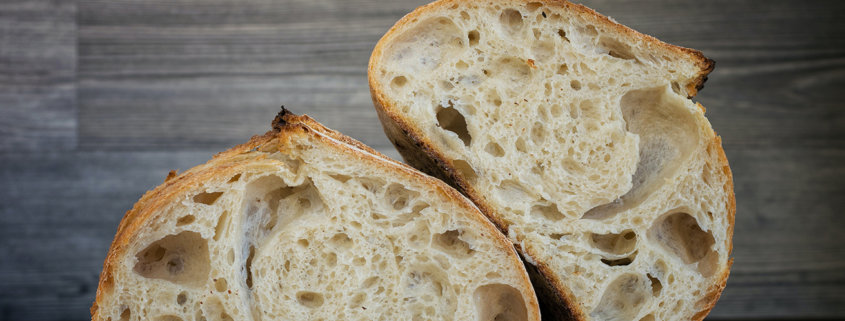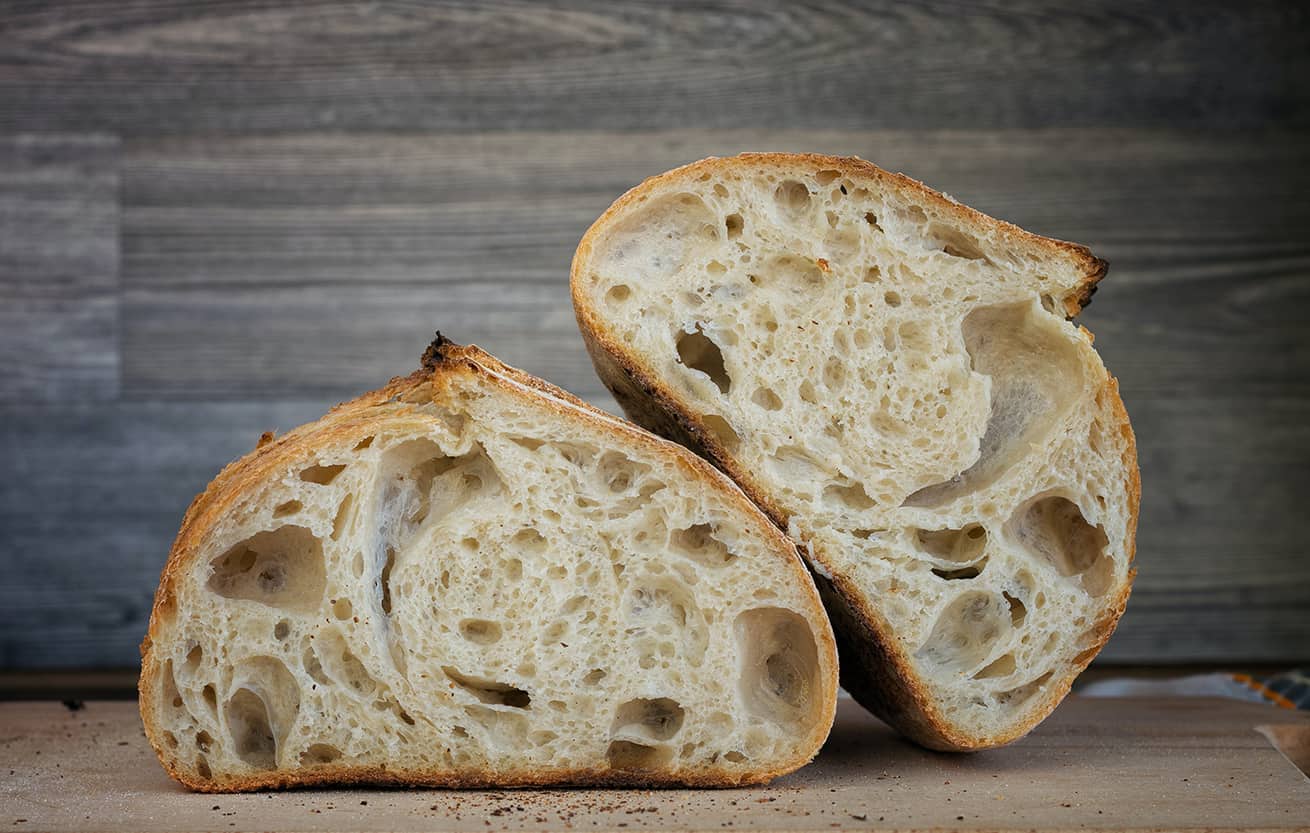Ingenious Tips for How to Store Bread To Keep It Fresher Longer
Bread has a certain shelf life, beyond which it can go stale, become moldy, and in a short time, inedible. It is possible to extend its delicious lifespan once you understand the ins and outs of how to store bread.
It’s the starch in any baked goods that makes them become stale. Exposure to air and heat can make the starch crystallize or degrade more quickly. Trapped moisture is what hastens the process of mold growth.
Store-bought sandwich bread and other commercial bakery products can have a much longer shelf-life because they are made with preservatives. Homemade or bakery artisan bread that is preservative-free, can turn stale or become moldy much more quickly.
Whether store-bought or homemade, is it asking too much for bread to remain fresh long enough to use it up to the last crumb? It’s not, that begs the question why does bread become stale or even grow mold so quickly?
It’s a storage problem. If you don’t like throwing out the rest of the hardened, stale, or even moldy bread pieces, I have some ingenious tips to keep bread fresher for longer— up to the very last fresh, delicious crumb.
48 Hour Rule
For bread that has just been baked (or purchased at the supermarket or bakery) that you intend to use up within 48 hours, leave it out, completely uncovered, at room temperature on baking day. The crust on freshly baked bread will remain at its best texture for at least one day, if not two full days. If you have made multiple loaves that you will not consume within 48 hours, freeze them, following the steps that follow.
If you slice into your bread, it is best practice to leave it cut-side down on a cutting board uncovered, particularly if you enjoy a crisp crust. This will help protect the interior from drying out, but not result in any moisture collecting on the crust and it becoming too soft.
If you have not sliced into your bread on the day of baking but have every intention of consuming within 48 hours, once completely cool, place the whole loaf in a large paper bag or reusable linen bread bag, and close it. While the crust won’t be quite as crisp as the first day of baking, the porousness of the paper bag will allow air to circulate, and will not trap moisture inside, while helping it not to dry out too quickly.
How to Store Bread in Freezer
A frozen loaf of bread can taste just as good as the freshly baked loaf when handled properly. The icy temperatures of your freezer prevent the dreaded starch degradation, holding the bread in a stable state.
Whole loaf
To freeze entire loaves of bread, allow the bread to cool completely, then transfer to a large, durable Ziplock bag, press out any excess air, and seal. If you prefer, you can wrap the loaf tightly in plastic wrap, aluminum foil, or place it in a small paper bag, and then transfer it to a heavy freezer zipper bag.
Pre-sliced
Instead of freezing an entire loaf at a time, it’s best to pre-slice it. That makes your loaves easier to work with when you need to make a single sandwich or piece of toast. This method works well with all kinds of bread, including bagels (never freeze bagels without slicing them in half first). Some experts suggest placing a piece of waxed paper between slices to make it even easier to remove a single slice or two.
The prep of pre-slicing might seem time-consuming, but you’ll be grateful you did the work when it’s time for breakfast.
- RELATED: Homemade English Muffin Bread
How to Use Pre-Sliced Frozen Bread
Slices of frozen bread will thaw quickly, in 5 to 10 minutes, when placed on the counter or cutting board. Or you can place a frozen slice right into the toaster and proceed without any thaw time. It may take a minute longer to toast up, but it’s quite easy.
How to Refresh Whole Loaves of Bread
Allow a frozen loaf of bread to thaw (in the freezer bag) at room temperature for several hours or overnight on your countertop the night before.
Preheat the oven to 350 F (175 C) for at least 20 minutes with a rack in the center position.
Once the oven has reached temperature, remove the loaf of bread from the bag and run it, very quickly, under cold water. You do not want to saturate the loaf, just lightly spray it evenly with cold water on all sides. This will create a tiny bit of steam in the oven, resulting in a crisper, fresher crust than placing a dry loaf in the oven.
Place the moistened whole loaf of bread directly on the oven rack and bake for 15 to 20 minutes or until the crust is crisp. Don’t err on the side of putting that loaf into a cold oven or even one that has not reached 350 F. It will stick to the rack and make a mess. But cold loaf on hot rack? Perfect.
Remove the perfectly crisped, refreshed loaf of bread from the oven and allow it to cool completely on a cooling rack before slicing.
Do Not Store Bread in the Refrigerator
It may seem like a good idea to store bread in the refrigerator, but it’s not ideal. I have not discovered even one professional baker or seasoned home baker who even slightly suggests it’s okay to refrigerate bread. On the contrary, they seem to be uniformly horrified by even the suggestion!
The temperature of a refrigerator prompts immediate “starch degradation,” a process that accelerates moisture loss causing the bread to become prematurely stale. It’s true that refrigeration will stave off mold, but even tightly wrapped bread stored in the refrigerator is going to harden, change in texture and flavor, and quickly become stale.















What is the best way to freeze hamburger and hot dog buns and not get freezer burn.
Call me lazy, but I put the bag straight into the freezer as it comes from the store. Then I open it take out what I need, close it up and shut the freezer door. I wrap the frozen bun(s) in a paper towel, pop it in the microwave using “Defrost” setting set to 1 or 2 mins. Perfect, every time!
When I get a store bought loaf of bread out of the freezer, I open it, put a papertowel under the bread, inside the wrapper. Allow the bag to get some air in it, and close up tight. When it thaws completely, remove the papertowel, or it can dry out the bread. Your loaf will remain soft, and taste as good as before it was frozen, no soggy or hard crust. Also, and I don’t know why, don’t put your loaf on the bare freezer shelf, put it on top of other things.
There are many delicious recipes for using bread ‘on its last legs.’ Any thing that soaks bread in a liquid or an egg-liquid mixture ‘revives’ the bread: french toast, bread-pudding, lots of casseroles.
My home-economist grandmother had a cheese+milk&egg-soaked bread casserole called ‘Strata’ which puffed up like a souffle and could be adapted to incorporate left-overs;it came from an early JOY OF COOKING cookbook. She demonstrated it to women in the ‘hard times’ of the 1930s as an incentive to replace wood stoves with new ‘electric ranges.’
My husband enjoys it so much I think he hides hamb/hot dog buns so they stale and then suggests that we have ‘strata’ for supper.
Thanks for this article. I am a cottage baker and typically sell at vendor markets. At every event, at least one person asks “How long will this last”. I shared your article to my Facebook page and now I can refer shoppers to it! Great article!
Thanks for the share Kathy!
I make homemade bread & use an electric slicer. I place 3 slices separated with waxed paper in a sandwich bag. Then I place the sandwich bags inside a gallon freezer bag. I can then lay it flat in my limited freezer space. I pull out a baggie every day or 2 and that way have fresh bread to eat. This I also do with store bought bread. I reuse the waxed paper pieces & baggies so I’m not wasting resources. Your site has taught me to rethink how to be more thrifty especially now that I’m retired. Thank you, Mary for all the inspiration.
Hi Mary,
I buy Organic Thin Sliced Whole Wheat bread.
Is it still OK to freeze slices of it?
(I will put wax paper in between the slices it makes it easier to be able to take out 1 or 2 slices per use.) I’ve heard.
Yes, freezing is ideal to retain freshness, nutrition… all of that.
Thank you so much Mary.
I really appreciate it,
as we waste a lot of bread that has gone moldy. I am allergic to mold.
This way I won’t waste it!!!! : )
I have double-bagged my bread (store-bought, sliced) and put in the freezer, only to have it be hard and stale after 1-2 weeks, especially on one end or corner of every piece. Ideas or thoughts of how to prevent? Thanks.
Here’s a great tip: Lay a paper towel inside the bag on top of the bread, then seal it up and place in freezer. I don’t know why that works so well, but it does!
The oils and bacteria on your fingers will also cause bread to mold quickly. Use tongs, food service gloves, or a small piece of cling film to cover your fingers to remove the slices from a loaf to avoid transferring to the bread or wrapping. Teach this tip to the family members that like to remove slices from the “middle’ of a loaf so they don’t contaminate the rest of it.
Do you have any resource or documentation for this, Kodnat?
In food service training, handlers are taught that all foods that will not be cooked should be handled with either clean utensils or gloved hands to prevent contamination. One exercise commonly performed is to have a food handler wash their hands then touch 3 common “clean” items before a swab is cultured. Within a day, the petri dishes grow bacterial and mold specimens from common clean objects.
Reminds me of Mary’s tip regarding touching shredded cheese in a bag. since I read her warning against doing this with cheese, I will start doing it with my loaf of bread too.